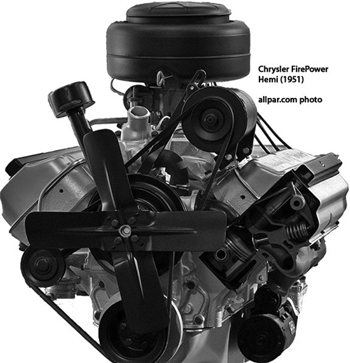 By Randy Rundle
By Randy Rundle
So, you think you know your Chrysler history? And you can name every application Chrysler ever put a Hemi engine into?
Well, I have one I bet you’ve never heard of. Chrysler, like most automotive companies, secured contracts during World War II to build tanks and airplanes, as well as guns and ammunition.
Chrysler was no different than all the rest, with one exception, the air raid siren.
Chrysler earned the distinction during the war years of building the loudest, most powerful warning device ever built.
No company before or since has built anything like it.
Development of what would be later became known as the Chrysler Air Raid Siren was started in January 1942.
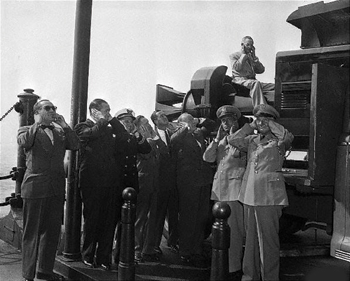 First attempts were built at the request of the Office of Civil Defense in Washington D.C. The E.D. Bullard Company of San Francisco designed an engine-driven centrifugal siren and submitted it for testing and certification.
First attempts were built at the request of the Office of Civil Defense in Washington D.C. The E.D. Bullard Company of San Francisco designed an engine-driven centrifugal siren and submitted it for testing and certification.
Chrysler got involved in part because the centrifugal engine-driven siren offered by the Bullard Company used its Flathead six-cylinder engine to power the siren.
However, despite extensive tests and modifications, the Bullard-designed siren could not produce the necessary volume of sound.
In earlier research, the Office of Civil Defense had determined that a minimum sound pressure of 120 to 140 decibels at 100 feet was the minimum requirement output for a warning siren.
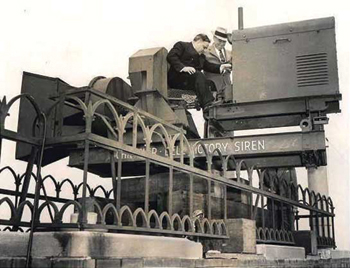 With the failure of the Bullard Company siren to meet the specifications, Chrysler was invited to a meeting in Washington D.C., along with a few of the sound engineers from Bell Laboratories, to work on the problem and come up with a solution.
With the failure of the Bullard Company siren to meet the specifications, Chrysler was invited to a meeting in Washington D.C., along with a few of the sound engineers from Bell Laboratories, to work on the problem and come up with a solution.
With Harry Fletcher of Bell Labs in charge, he and his engineers went to work. Within a few months they introduced “Big Bertha,” a huge centrifugal engine-driven siren — one of the largest ever built at that time.
The Bell Labs siren was capable of 124 decibels of sound at a range of 100 feet. Now that the Bell siren design was proven successful, the Bell engineers drew up a series of specifications, using “Big Bertha” as a guideline, and Chrysler was then awarded a contract to build the Bell-designed-and-engineered air raid warning sirens.
The first version became known as the Chrysler-Bell Victory Siren.
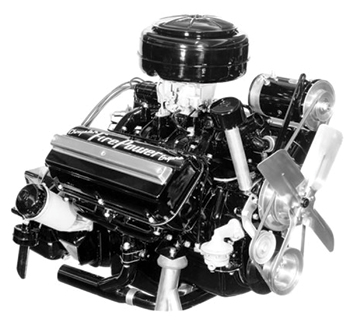 This first siren had a somewhat crude unrefined appearance, and despite its looks, it became certified by the Office of Civil Defense in March 1942.
This first siren had a somewhat crude unrefined appearance, and despite its looks, it became certified by the Office of Civil Defense in March 1942.
One-hundred-twenty of these “Victory Sirens” were sold to 28 different cities, among them New York City, which bought 10 of them. The city of Detroit bought 20, as did the city of Chicago.
The Victory Sirens sold for the tidy sum of $3,760 each in 1942 wartime dollars and were powered by a Chrysler straight-eight 324 cubic-inch engine that was rated at 140 hp. The government test results showed this siren with its two-stage blower was capable of producing a sound output of 130 decibels at a frequency of 430 Hz at a distance of 100 feet.
One of the problems with the early sirens is that the sound they produced was directional. To solve that problem, the sirens were fitted onto a belt-driven turntable that would rotate a full 360 degrees at 1.5 revolutions a minute.
An operator was required to sit on a tractor-type seat and control the operation of the siren and the direction of rotation, a job for which I am sure there were plenty of volunteers.
The second design of this siren built by Chrysler was much more refined than the first. Improvements in design also made the assembly of the sirens easier, faster and less expensive.
In the second design, the Bell name was dropped, and the sirens simply became known as the Chrysler Air Raid Siren. This design used the same 140 hp engine as the first, with the sound output said to be the same. The second series was built from the middle 1940s through 1951.
In 1952, a final and more advanced model was introduced that came with a few more refinements, including the addition of Chrysler’s new 331 cubic-inch, Hemi-Head V8, which produced 180 hp at 4,600 rpms. 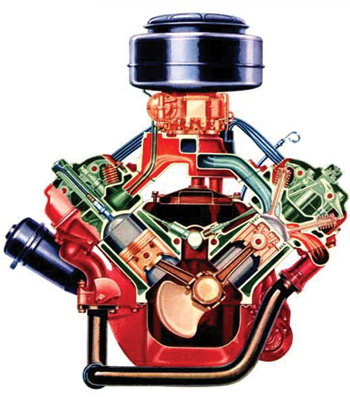
The latest design proved to be the best ever. It was by far the loudest at 138 db at a distance of 100 feet at a range of 460 Hz. Best of all, it was controlled remotely so no operator was needed to ride the siren and run the controls.
To put this Hemi-powered air raid siren’s output loudness into perspective, the telephone in your shop rings at 80 db, while a city police car or ambulance measures 120 db at a distance of 10 feet. Now imagine 138 db at a distance of 100 feet!
This design became the most popular and a couple of hundred were sold to the larger cities across the United States. Besides their tour of duty for World War II, many of the sirens were again used during the Cold War in the 1960s when the threat of nuclear war became very real.
While no examples of the first two siren designs are known to have survived, a few of the third design (which was built up through 1957) are still around. Enter one Harry Barry, who remembers as a kid growing up that there was one of the third-generation sirens near his school. It was tested each month and Harry remembers that very loud, distinctive sound.
In later years, Harry became interested in sirens (no doubt influenced by his early childhood), and went back to see if the siren was still there, next to his old school. It was and he bought it. He then went to work and restored it. Since then he has tracked down and bought one more, and knows the whereabouts of six others.
So, the next time you’re at a car show and come across a 1957 Chrysler, you may want to take a moment, and reflect on what might have been.
Instead of rumbling under the hood of that finned Chrysler, the Hemi engine in that car could have spent its life in service to our country powering one of the loudest and most powerful air raid sirens ever built. 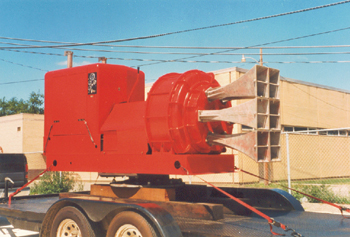
Who would have thought?
Read more on these sirens and view historic photos at www.victorysiren.com.
